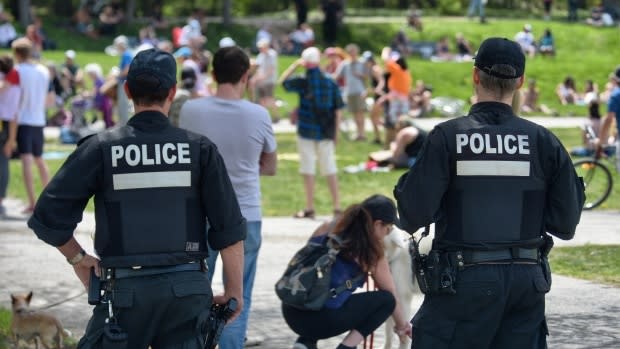Why reopening Montreal is a riskier bet than Legault is letting on

The riskiest part yet of Premier Francois Legault's plan to end Quebec's pandemic lockdown gets underway today, as retail stores across the Montreal area open for the first time in nearly two months.
At the same time, factories in Quebec will also be able to resume operating at full capacity. This follows the first weekend after the government ended its ban on small outdoor gatherings, and there was nary a Montrealer left inside.
So in the span of a few days, hundreds of thousands of people will be back working, shopping and commuting in the Canadian city where the novel coronavirus has spread most widely and been most deadly.
The previous phases of Legault's plan were a safer bet. When elementary schools, daycares and stores outside Montreal were allowed to reopen, transmission rates were already decreasing.
And so far — fingers crossed, knock on wood — these areas of the province haven't seen a serious uptick in cases, hospitalizations or deaths.
But there is a different order of uncertainty when it comes to lifting confinement measures in Montreal, and the suburbs that ring the island.
The province has recorded 47,411 cases of COVID-19, of which about 80 per cent are in the Greater Montreal area.

While there have been some improvements in the key indicators, it hasn't been enough to completely erase the fears of epidemiologists. The daily number of deaths is dropping and the average number of new cases is also inching downward despite more testing.
"There are some small signs of hope, but I'm very worried about what will happen in the next few weeks," said Mathieu Maheu-Giroux, an assistant professor at McGill University who helps prepare projections for the province's public health research institute.
"Hopefully this will give us some respite to be able to mount a more effective response for a potential second wave that could be worse than the first one."
But as Legault continues to lift restrictions, some key factors that have contributed to the ongoing disaster remain unaddressed.
The staffing crisis in long-term care homes
The scope of the tragedy in Quebec — nearly 4,000 dead — can be explained in no small part by the staffing shortage it caused in the health-care system.
Until last week, there were routinely more than 11,000 health-care workers who were absent on any given day. In many cases, these were front-line workers — doctors, yes, but more critically nurses and patient attendants.
These absences compounded already existing staffing shortages in the system, particularly in the province's network of long-term care homes (known as CHSLDs).
It was understaffed long-term care homes that generated the most vivid traumas to date: elderly patients left unattended for hours and dying alone, sometimes in their own filth.
The staffing shortage prevented the implementation of a policy that could have saved dozens of lives.
On April 3, Quebec issued a directive urging CHSLD staff to avoid working in several different facilities, fearing they were carrying the disease with them as they went from one location to another.
A similar policy was implemented in British Columbia, and public health experts there have lauded it for effectively halting the spread of COVID-19 in the province's nursing homes.
But more than a month later, Quebec still hasn't been able to put an end to the practice.
Given the continuing shortage of workers in the CHSLD network, it's either maintain the practice or leave patients without basic care. Health-care managers are forced to choose the lesser of two evils.
A provincewide recruitment effort, bonuses, redeploying medical specialists, calling in the army — none of the government's solutions have generated sufficient replacements.
The staffing situation has improved more recently. By the end of last week, there were 10,415 health-care workers absent either because they've tested positive for COVID-19 or are in preventative isolation.
That's roughly 1,000 fewer than the week before.
But it is still unclear when care homes will be able to fully implement the policy.
At a National Assembly hearing on Friday, Health Minister Danielle McCann criticized the practice of moving CHSLD workers around.
Asked when it would end, she replied: "I don't have a precise date."
WATCH | Concerns that Quebec, Ontario reopened too soon:
Crowded Montreal hospitals
The Legault government has said hospital capacity is one of its key criteria for determining whether Montreal is ready for looser confinement measures.
When the premier previously delayed reopening stores in Montreal, and scratched reopening schools there altogether, he cited the space crunch in Montreal-area hospitals.
One benchmark that Legault has cited — borrowed from New York — is hospitals having at least 30 per cent of their beds available, in case easing the lockdown leads to a surge in new cases.

Quebec's hospital network was at 70 per cent capacity on May 16, but had climbed to 74.3 per cent by May 21, according to figures provided by the Ministry of Health.
Things are even tighter in Montreal and the surrounding area. On Thursday, hospital capacity in Montreal was at 77 per cent, in Montérégie it was at 84 per cent and was at 95 per cent in Laval.
"In Montreal, things are very, very, very tight," Dr. Germain Poirier, head of Quebec's society of intensive-care specialists, told CBC Montreal's Daybreak last week.
While there is more space available in intensive-care units, he said regular hospital beds are almost all taken. "If we have a second wave, that might be difficult."
Last week, Quebec suddenly changed how it counted hospitalizations. It stopped including COVID-19 patients who are well enough to be transferred back into long-term care, but are waiting for space to free up.
That allowed the province to register more than 200 fewer hospitalizations.

But as Poirer pointed out, these patients were still taking up hospital beds and still needed care from doctors and nurses.
"Maybe the [Health] Ministry wants to show that things are better," he said. "Are they really better in the field? I'm not so sure. We still see a lot of active cases."
It's on us now
Legault, in other words, has opted to ease the lockdown in Montreal at a moment when area hospitals have limited capacity to handle additional cases.
The staffing crisis in the CHSLD network remains a major public health risk, and there is still no conclusive evidence of a sustained decrease in transmission in and around the city.
From this vantage point, it appears the government is going forward less because Montreal is out of the danger zone, and more because the heavy lockdown is no longer sustainable.
Whether the health-care system can handle what happens next is now almost entirely in the hands of citizens, and their willingness to follow the conditions attached to their newly returned freedoms: wash hands, wear masks and stay two metres apart.


